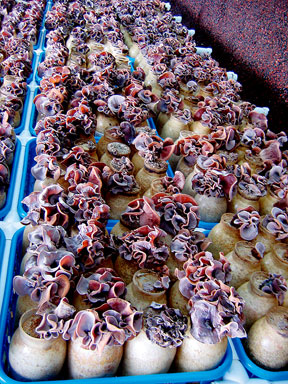
COURTESY HAMAKUA MUSHROOMS
Clusters of pepeiau mushrooms bloom in plastic bottles at the Hamakua Mushrooms farm. CLICK FOR LARGE
|
|
Mushroom farmer grows into the job
By Joan Namkoong
Special to the Star-Bulletin
LAUPAHOEHOE, Hawaii » Like the other fungi grown at Hamakua Mushrooms on the Big Island, pepeiao involved a long process of experimentation to bring to this first commercial harvest.
Mushrooms are fungi, mysterious living things that grow out of the wet ground on a warm day. They get their food and energy from their environment -- fallen logs, stumps, leaves, plants, animals or other fungi. Mother Nature spawns an incredible array of mushrooms.
Preparing pepeiao
"Unlike fruits and vegetables, cooking a mushroom brings out the vitamins and medicinal properties of mushrooms," says Janice Stanga of Hamakua Mushrooms. "Raw mushrooms are just fiber; cooking releases the nutrients."
To use pepeiao, cut off the base stem and slice "leaves" into thin shreds. Use in stir-fry dishes, spring-roll fillings and add to soups for textural crunch.
|
But the mushrooms we eat are rarely a result of Mother Nature's work. Supermarket versions come from commercial farms: Button mushrooms and portobellos grow in dark rooms in compost, while lighted rooms and plastic bottles filled with a mixture of sawdust and wheat bran provide the optimum growing conditions for forest or wood-decomposing fungi.
Rows and rows of plastic bottles are what you see when you enter one of the indoor growing rooms at Hamakua Mushrooms, a temperature-controlled facility designed to grow fungi. Just 3 years old, Hamakua Mushrooms supplies many a Hawaii restaurant, supermarket and Costco with a variety of specialty mushrooms that thrive in decomposing wood: gray oyster, white and brown shimeiji, enoki, nameko, erynggi (also known as alii), maitake and pioppini.
Owner Bob Stanga, a former helicopter pilot, began Hamakua Mushrooms when he sold his company, Makani Kai Helicopters, and his Kailua home and moved to the Big Island. He bought 35 acres of land and began reading about mushrooms. By 2003, with his wife, Janice, and son-in-law Joshua Martinez, he built a 16,000-square-foot facility that today produces nearly 4,000 pounds of mushrooms a week, employing 20 people from the Laupahoehoe area. He has literally created a fungal jungle.
"We use a Japanese cultivation method," Stanga explained. All the machinery used in this facility and the mushroom "seeds" are from Japan, where mushroom cultivation is state of the art.
Eucalyptus trees that grow along the Hamakua Coast provide the wood needed for the mushroom growing medium. Stanga has even built a small mill to grind logs. "We grind eucalyptus logs to the particle size we need. Mushrooms digest the wood."
The sawdust is mixed with wheat bran and moistened with water. Machines fill quart-size plastic bottles with the growing medium, then move them into a large tunnel that is sealed and heated to sterilize the mixture, killing any bacteria present. Conveyors move the sterilized bottles to a seeding room, where the mixture is injected with the fungi that will eventually grow into mushrooms. The bottles are capped and left to incubate at 75 degrees; the length of incubation can be anywhere from 21 days to 3 months.
The bottles are then uncapped and moved to cooler growing rooms where temperature and humidity are controlled according to the variety of mushroom being produced. It's a rather amazing sight: a cool, concrete room filled with plastic racks fashioned from PVC pipes, holding trays of plastic bottles from which clusters of fungi emerge. It can take 10 days or a few weeks for the mushrooms to bloom into clusters that emerge from the necks of the bottles.
The mushrooms are harvested by hand, broken off at their base. They are cooled overnight to lengthen shelf life, then packaged and shipped the next day.
IT HAS TAKEN Stanga more than two years to produce a pepeiao crop, and he's still experimenting. One day, out of frustration, he threw some plastic bottles containing pepeiao fungi outdoors because they just were not growing. A few days later, employees discovered pepeiao emerging from the bottles in nice, tight, rose-like clusters. "The 65-degree temperature of the growing rooms was too cool," Stanga said.
Now, after incubation, the mushroom bottles are placed on racks outdoors, surrounded by shade cloth. The warmer ambient temperature duplicates Mother Nature's usual growing environment. Stanga is still tweaking how the fungi will grow out of the bottle to achieve the desired clusters, but he expects the mushrooms to start appearing in Oahu stores soon.
There's more to the cycle of mushroom production: The growing medium in the bottles, relieved of its nutrients and having changed color from brown to white, is emptied and ground up to make a compost sought after by gardeners and landscapers. "Nothing is wasted," said Stanga.

